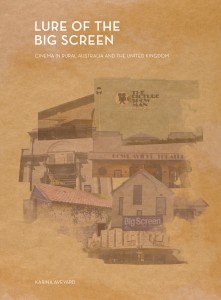The Lure of the Big Screen: Cinema in Rural Australia and the United Kingdom by Karina Aveyard (Intellect Press, 2015) 182 pages, ISBN: 978-1783203826 (hardback), £49
 About the reviewer: Dr Jonathan Rayner is Reader in Film Studies at the University of Sheffield. He is author of The Films of Peter Weir (1998/2003), Contemporary Australian Cinema (2000), The Naval War Film (2007), The Cinema of Michael Mann (2013), and co-editor (with Professor Graeme Harper) of Cinema and Landscape (2010) and Film Landscapes (2013).
About the reviewer: Dr Jonathan Rayner is Reader in Film Studies at the University of Sheffield. He is author of The Films of Peter Weir (1998/2003), Contemporary Australian Cinema (2000), The Naval War Film (2007), The Cinema of Michael Mann (2013), and co-editor (with Professor Graeme Harper) of Cinema and Landscape (2010) and Film Landscapes (2013).
The consideration of the act of cinema-going has always been an underdeveloped area of film studies. Traditionally, evaluating how (and why) people go to see films has not entered the critical or theoretical precincts of academic thinking, which has tended to concentrate instead on film as an art, and cinema as an industry. The intellectual and elitist emphases upon the making, reading and contextualisation of the cinema as the most important medium of the last century have side-lined the ordinary viewers’ relationships with films that that they travel, pay, and love, to watch. Karina Aveyard’s study exemplifies the research which has striven in recent years to redress this imbalance, by posing simple but penetrating questions about the patterns of film viewing which characterise modern audiences. However, what distinguishes this book is its focus on groups of viewers outside of the usually imposed norms of the youth-orientated mainstream and the exclusivity of the art cinema. Instead this study explores a variety of differently defined cinematic hinterlands and minority viewer-groups in the comparable but distinctive contexts of Australia and the UK. It is both bold and broad in its confrontation with large-scale and long-term trends in cinema-going, exhibition practice, audience taste and technological development, and intimate and insightful in its engagement with ordinary people’s goals, experiences and impulses for showing and going to see films.
 The book divides its examination into seven chapters, with the introduction discussing and problematizing its terms (determining what constitutes the ‘rural’, culturally as much as geographically, in both countries) and exploring its targeting of those running and patronising cinemas outside of major urban centres. Inevitably this discussion leads to a detailed consideration of ‘standard’ modes of cinema-going, reflecting on the practices of distribution and exhibition which have produced a revival in cinema attendance while increasingly circumscribing viewing choice and regulating audiences geographically, demographically and economically. This debate also entails a timely and insightful consideration of how digital formats are subtly changing the cinematic landscape throughout the exhibition sector, for better and worse. In itemising other categories of exhibition (‘subsidized’, ‘community’ and ‘improvised’ cinemas) beyond the commercial chains and independent cinemas, the study at once provides a useful framework for comparison while illustrating that no two venues, locations or audiences truly resemble one another. Case studies with commentary from both the industry and audience sides flesh out each category, highlighting the regional and national variations. The highly individual visions and motivations of small cinema managers, film enthusiasts, community leaders and their audiences are shown to speak to entirely different, often closely tailored commercial intentions on the one side, and specific use-economies on the other. The contrast to the architectural and cultural anonymity of the multiplex which these examples reveal could not be starker.
The book divides its examination into seven chapters, with the introduction discussing and problematizing its terms (determining what constitutes the ‘rural’, culturally as much as geographically, in both countries) and exploring its targeting of those running and patronising cinemas outside of major urban centres. Inevitably this discussion leads to a detailed consideration of ‘standard’ modes of cinema-going, reflecting on the practices of distribution and exhibition which have produced a revival in cinema attendance while increasingly circumscribing viewing choice and regulating audiences geographically, demographically and economically. This debate also entails a timely and insightful consideration of how digital formats are subtly changing the cinematic landscape throughout the exhibition sector, for better and worse. In itemising other categories of exhibition (‘subsidized’, ‘community’ and ‘improvised’ cinemas) beyond the commercial chains and independent cinemas, the study at once provides a useful framework for comparison while illustrating that no two venues, locations or audiences truly resemble one another. Case studies with commentary from both the industry and audience sides flesh out each category, highlighting the regional and national variations. The highly individual visions and motivations of small cinema managers, film enthusiasts, community leaders and their audiences are shown to speak to entirely different, often closely tailored commercial intentions on the one side, and specific use-economies on the other. The contrast to the architectural and cultural anonymity of the multiplex which these examples reveal could not be starker.
If there is no such thing as a standard rural cinema, then there are no ordinary or average viewers either. The communities and activities of film-going which Aveyard’s book acknowledges, probes and illuminates with interviews do, admittedly, stand as partial witnesses and examples of much wider and more variegated practices. Yet the scale and diversity of the research field which this book stakes out do not at all invalidate the exercise. Instead it provides a tantalisingly restricted iris-in on some of the ways people choose to show and view their films beyond the homogenisation of the multiplex. The examination is accessible but detailed, exploratory but opinionated, and illustrated with snap-shot photographs of the venues which reflect the personal nature of the interviews and experiences described. (I am proud to say I know some of the East Anglian cinemas described in the book myself). The enticement contained in the title - ‘the lure of the big screen’ – is keenly cross-examined, in the realisations that the screens audiences are lured to are seldom (and do not have to be) big, and in any case the screen is seldom the only or even primary lure. It is good to be reminded of the myriad reasons (social, familial, communal, individual) that people frequent the places in which movies are seen, and to acknowledge that the raw data of ticket sales or subjective recollections from personal life only tell part of the story. However, this book’s combination of both these sources of information produces an intricate, multifaceted and highly nuanced picture of the different possible manifestations of interaction that the cinema produces at grassroots level.
Dr Jonathan Rayner